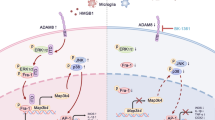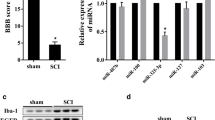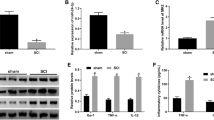Abstract
The secondary injury of spinal cord injury (SCI) is dominated by neuroinflammation, which was caused by microglia M1 polarization. This study aimed to investigate the role and mechanism of Htr2b on neuroinflammation of SCI. The BV2 and HMC3 microglia were treated with lipopolysaccharide (LPS) or interferon (IFN)-γ to simulate in vitro models of SCI. Sprague–Dawley rats were subjected to the T10 laminectomy to induce animal model of SCI. Htr2b mRNA expression was measured by qRT-PCR. The expression of Htr2b and Iba-1 was detected by western blot and immunofluorescence. The expression of inflammatory cytokines in vitro and in vivo was also measured. Kyoto Encyclopedia of Genes and Genomes (KEGG) was employed to analyze Htr2b-regulated signaling pathways. Rat behavior was analyzed by the Basso, Beattie, and Bresnahan (BBB) and inclined plane test. Rat dorsal horn tissues were stained by hematoxylin–eosin (H&E) and Nissl to measure neuron loss. Htr2b was highly expressed in LPS- and IFN-γ-treated microglia and SCI rats. SCI modeling promoted M1 microglia polarization and increased levels of inflammatory cytokines. Inhibition of Htr2b by Htr2b shRNA or RS-127445 reduced the expression of Htr2b, Iba-1, and iNOS and suppressed cytokine levels. KEGG showed that Htr2b inhibited ErbB signaling pathway. Inhibition of Htr2b increased protein expression of neuregulin-1 (Nrg-1) and p-ErbB4. Inhibition of the ErbB signaling pathway markedly reversed the effect of Htr2b shRNA on M1 microglia polarization and inflammatory cytokines. Htr2b promotes M1 microglia polarization and neuroinflammation after SCI by inhibiting Nrg-1/ErbB signaling pathway.






Similar content being viewed by others
Data availability
The datasets used and analyzed during the current study are available from the corresponding author on reasonable request.
References
Mothe AJ, Tator CH (2012) Advances in stem cell therapy for spinal cord injury. J Clin Investig 122(11):3824–3834
Nakamura M, Okano H (2013) Cell transplantation therapies for spinal cord injury focusing on induced pluripotent stem cells. Cell Res 23(1):70–80
Dietz V, Fouad K (2014) Restoration of sensorimotor functions after spinal cord injury. Brain 137(Pt 3):654–667
Silva NA, Sousa N, Reis RL, Salgado AJ (2014) From basics to clinical: a comprehensive review on spinal cord injury. Prog Neurobiol 114:25–57
Assinck P, Duncan GJ, Hilton BJ, Plemel JR, Tetzlaff W (2017) Cell transplantation therapy for spinal cord injury. Nat Neurosci 20(5):637–647
Torres-Espín A, Haefeli J, Ehsanian R, Torres D, Almeida CA, Huie JR, Chou A, Morozov D et al (2021) Topological network analysis of patient similarity for precision management of acute blood pressure in spinal cord injury. Elife 16(10):68015
Bourguignon L, Tong B, Geisler F, Schubert M, Röhrich F, Saur M, Weidner N, Rupp R et al (2022) International surveillance study in acute spinal cord injury confirms viability of multinational clinical trials. BMC Med 20(1):022–02395
Courtine G, Sofroniew MV (2019) Spinal cord repair: advances in biology and technology. Nat Med 25(6):898–908
Hutson TH, Di Giovanni S (2019) The translational landscape in spinal cord injury: focus on neuroplasticity and regeneration. Nat Rev Neurol 15(12):732–745
Zhou Y, Dong Q, Pan Z, Song Y, Su P, Niu Y, Sun Y, Liu D (2019) Hyperbaric Oxygen Improves Functional Recovery of the Injured Spinal Cord by Inhibiting Inflammation and Glial Scar Formation. Am J Phys Med Rehabil 98(10):914–920
Wang B, Shen PF, Qu YX, Zheng C, Xu JD, Xie ZK, Cao XJ (2019) miR-940 promotes spinal cord injury recovery by inhibiting TLR4/NF-κB pathway-mediated inflammation. Eur Rev Med Pharmacol Sci 23(8):3190–3197
Deng J, Meng F, Zhang K, Gao J, Liu Z, Li M, Liu X, Li J et al (2022) Emerging roles of microglia depletion in the treatment of spinal cord injury. Cells 11 (12):1871
Hilton BJ, Moulson AJ, Tetzlaff W (2017) Neuroprotection and secondary damage following spinal cord injury: concepts and methods. Neurosci Lett 652:3–10
Zeng H, Liu N, Yang YY, Xing HY, Liu XX, Li F, La GY, Huang MJ et al (2019) Lentivirus-mediated downregulation of α-synuclein reduces neuroinflammation and promotes functional recovery in rats with spinal cord injury. J Neuroinflammation 16(1):019–1658
Mills CD, Kincaid K, Alt JM, Heilman MJ, Hill AM (2000) M-1/M-2 macrophages and the Th1/Th2 paradigm. J Immunol 164(12):6166–6173
Lv ZC, Cao XY, Guo YX, Zhang XD, Ding J, Geng J, Feng K, Niu H (2019) Effects of MiR-146a on repair and inflammation in rats with spinal cord injury through the TLR/NF-κB signaling pathway. Eur Rev Med Pharmacol Sci 23(11):4558–4563
Launay JM, Schneider B, Loric S, Da Prada M, Kellermann O (2006) Serotonin transport and serotonin transporter-mediated antidepressant recognition are controlled by 5-HT2B receptor signaling in serotonergic neuronal cells. Faseb J 20(11):1843–1854
Mao L, Xin F, Ren J, Xu S, Huang H, Zha X, Wen X, Gu G et al (2022) 5-HT2B-mediated serotonin activation in enterocytes suppresses colitis-associated cancer initiation and promotes cancer progression. Theranostics 12(8):3928–3945
Radke AK, Piantadosi PT, Uhl GR, Hall FS, Holmes A (2020) Improved visual discrimination learning in mice with partial 5-HT2B gene deletion. Neurosci Lett 738:135378
Bevilacqua L, Doly S, Kaprio J, Yuan Q, Tikkanen R, Paunio T, Zhou Z, Wedenoja J et al (2010) A population-specific HTR2B stop codon predisposes to severe impulsivity. Nature 468(7327):1061–1066
Lacoste J, Lamy S, Ramoz N (2020) A positive association between a polymorphism in the HTR2B gene and cocaine-crack in a French Afro-Caribbean population. 21(10):784–789
Montalvo-Ortiz JL, Zhou H (2018) Translational studies support a role for serotonin 2B receptor (HTR2B) gene in aggression-related cannabis response. 23(12):2277–2286
Choi WG, Choi W, Oh TJ, Cha HN, Hwang I, Lee YK, Lee SY, Shin H et al (2021) Inhibiting serotonin signaling through HTR2B in visceral adipose tissue improves obesity-related insulin resistance. The J Clin Investig 131(23):e145331
Yang T, Wang H, Li Y, Zeng Z, Shen Y, Wan C, Wu Y, Dong J et al (2020) Serotonin receptors 5-HTR2A and 5-HTR2B are involved in cigarette smoke-induced airway inflammation, mucus hypersecretion and airway remodeling in mice. Int Immunopharmacol 81:106036
Kataria H, Alizadeh A, Karimi-Abdolrezaee S (2019) Neuregulin-1/ErbB network: An emerging modulator of nervous system injury and repair. Prog Neurobiol 180:101643
Gauthier MK, Kosciuczyk K, Tapley L, Karimi-Abdolrezaee S (2013) Dysregulation of the neuregulin-1-ErbB network modulates endogenous oligodendrocyte differentiation and preservation after spinal cord injury. Eur J Neurosci 38(5):2693–2715
Zhao YJ, Qiao H, Liu DF, Li J, Li JX, Chang SE, Lu T, Li FT et al (2022) Lithium promotes recovery after spinal cord injury. Neural Regen Res 17(6):1324–1333
Basso DM, Beattie MS, Bresnahan JC (1995) A sensitive and reliable locomotor rating scale for open field testing in rats. J Neurotrauma 12(1):1–21
Livak KJ, Schmittgen TD (2001) Analysis of relative gene expression data using real-time quantitative PCR and the 2(-Delta Delta C(T)) Method. Methods 25(4):402–408
Sun J, Zhou YQ, Xu BY, Li JY, Zhang LQ, Li DY, Zhang S, Wu JY et al (2021) STING/NF-κB/IL-6-Mediated Inflammation in Microglia Contributes to Spared Nerve Injury (SNI)-Induced Pain Initiation. J Neuroimmune Pharmacol 2(10):021–10031
Chen G, Zhang YQ, Qadri YJ, Serhan CN, Ji RR (2018) Microglia in Pain: Detrimental and Protective Roles in Pathogenesis and Resolution of Pain. Neuron 100(6):1292–1311
Wang L, Yin C, Liu T, Abdul M, Zhou Y, Cao JL, Lu C (2020) Pellino1 regulates neuropathic pain as well as microglial activation through the regulation of MAPK/NF-κB signaling in the spinal cord. J Neuroinflammation 17(1):020–01754
Gensel JC, Donnelly DJ, Popovich PG (2011) Spinal cord injury therapies in humans: an overview of current clinical trials and their potential effects on intrinsic CNS macrophages. Expert Opin Ther Targets 15(4):505–518
Swaroop S, Mahadevan A, Shankar SK, Adlakha YK, Basu A (2018) HSP60 critically regulates endogenous IL-1β production in activated microglia by stimulating NLRP3 inflammasome pathway. J Neuroinflammation 15(1):018–1214
Pineau I, Lacroix S (2007) Proinflammatory cytokine synthesis in the injured mouse spinal cord: multiphasic expression pattern and identification of the cell types involved. J Comp Neurol 500(2):267–285
Longbrake EE, Lai W, Ankeny DP, Popovich PG (2007) Characterization and modeling of monocyte-derived macrophages after spinal cord injury. J Neurochem 102(4):1083–1094
Brennan FH, Li Y, Wang C (2022) Microglia coordinate cellular interactions during spinal cord repair in mice. 13(1):4096
Xu S, Wang J, Zhong J, Shao M, Jiang J, Song J, Zhu W, Zhang F et al (2021) CD73 alleviates GSDMD-mediated microglia pyroptosis in spinal cord injury through PI3K/AKT/Foxo1 signaling. Clin Transl Med 11(1):269
Zhang L, Zhuang X, Kotitalo P, Keller T, Krzyczmonik A, Haaparanta-Solin M, Solin O, Forsback S et al (2021) Intravenous transplantation of olfactory ensheathing cells reduces neuroinflammation after spinal cord injury via interleukin-1 receptor antagonist. Theranostics 11(3):1147–1161
Liu Z, Yao X, Sun B, Jiang W, Liao C, Dai X, Chen Y, Chen J et al (2021) Pretreatment with kaempferol attenuates microglia-mediate neuroinflammation by inhibiting MAPKs-NF-κB signaling pathway and pyroptosis after secondary spinal cord injury. Free Radic Biol Med 168:142–154
Yang EJ, Song IS, Song KS (2019) Ethanol extract of Glycyrrhizae Radix modulates the responses of antigen-specific splenocytes in experimental autoimmune encephalomyelitis. Phytomed Int J Phytother Phytopharmacol 54:56–65
Olayioye MA, Neve RM, Lane HA, Hynes NE (2000) The ErbB signaling network: receptor heterodimerization in development and cancer. Embo J 19(13):3159–3167
Imoto H, Zhang S, Okada M (2020) A computational framework for prediction and analysis of cancer signaling dynamics from RNA sequencing data-application to the ErbB receptor signaling pathway. Cancers 12(10):2878
Ryzhov S, Matafonov A, Galindo CL, Zhang Q, Tran TL, Lenihan DJ, Lenneman CG, Feoktistov I et al (2017) ERBB signaling attenuates proinflammatory activation of nonclassical monocytes. Am J Physiol Heart Circ Physiol 312(5):H907–H918
Vermeulen Z, Hervent AS, Dugaucquier L, Vandekerckhove L, Rombouts M, Beyens M, Schrijvers DM, De Meyer GRY et al (2017) Inhibitory actions of the NRG-1/ErbB4 pathway in macrophages during tissue fibrosis in the heart, skin, and lung. Am J Physiol Heart Circ Physiol 313(5):H934–H945
Hardbower DM, Singh K, Asim M, Verriere TG, Olivares-Villagómez D, Barry DP, Allaman MM, Washington MK et al (2016) EGFR regulates macrophage activation and function in bacterial infection. J Clin Invest 126(9):3296–3312
Schumacher MA, Hedl M, Abraham C, Bernard JK, Lozano PR, Hsieh JJ, Almohazey D, Bucar EB et al (2017) ErbB4 signaling stimulates pro-inflammatory macrophage apoptosis and limits colonic inflammation. Cell Death Dis 8(2):42
Pitcher GM, Kalia LV, Ng D, Goodfellow NM, Yee KT, Lambe EK, Salter MW (2011) Schizophrenia susceptibility pathway neuregulin 1-ErbB4 suppresses Src upregulation of NMDA receptors. Nat Med 17(4):470–478
Zhu JM, Li KX, Cao SX, Chen XJ, Shen CJ, Zhang Y, Geng HY, Chen BQ et al (2017) Increased NRG1-ErbB4 signaling in human symptomatic epilepsy. Sci Rep 7(1):017–00207
Ma Y, Fan P, Zhao R, Zhang Y, Wang X, Cui W (2022) Neuregulin-1 regulates the conversion of M1/M2 microglia phenotype via ErbB4-dependent inhibition of the NF-κB pathway. 49 (5):3975–3986
Xu J, Hu C, Chen S, Shen H, Jiang Q, Huang P, Zhao W (2017) Neuregulin-1 protects mouse cerebellum against oxidative stress and neuroinflammation. Brain Res 1670:32–43
Orr MB, Gensel JC (2018) Spinal Cord Injury Scarring and Inflammation: Therapies Targeting Glial and Inflammatory Responses. Neurother The J Am Soc Exp NeuroTher 15(3):541–553
Funding
No funds, grants, or other support was received.
Author information
Authors and Affiliations
Contributions
Conception and design: WH C and XL G; Perform research: WL Y and X X; Data analysis and interpretation: X P and H L; Manuscript writing: All authors; Final approval of manuscript: All authors.
Corresponding author
Ethics declarations
Ethics approval and consent to participate
The experimental protocol of our study was performed in accordance with the Guide for the Care and Use of Laboratory Animals and approved by the Qilu Hospital, Cheeloo College of Medicine, Shandong University.
Consent for publication
Not Applicable.
Competing Interests
The authors declare that they have no conflicts of interest.
Additional information
Publisher's Note
Springer Nature remains neutral with regard to jurisdictional claims in published maps and institutional affiliations.
Wenhao Chen and Xianlei Gao are Co-first author.
Highlights
1. Htr2b is highly expressed in LPS- and IFN-γ-treated microglia and SCI rats;.
2. Inhibition of Htr2b represses M1 microglia polarization and inflammation;.
3. Htr2b inhibits the Nrg-1/ErbB signaling.
Rights and permissions
Springer Nature or its licensor (e.g. a society or other partner) holds exclusive rights to this article under a publishing agreement with the author(s) or other rightsholder(s); author self-archiving of the accepted manuscript version of this article is solely governed by the terms of such publishing agreement and applicable law.
About this article
Cite this article
Chen, W., Gao, X., Yang, W. et al. Htr2b Promotes M1 Microglia Polarization and Neuroinflammation after Spinal Cord Injury via Inhibition of Neuregulin-1/ErbB Signaling. Mol Neurobiol 61, 1643–1654 (2024). https://doi.org/10.1007/s12035-023-03656-6
Received:
Accepted:
Published:
Issue Date:
DOI: https://doi.org/10.1007/s12035-023-03656-6




